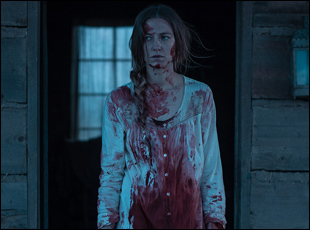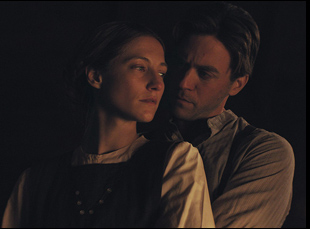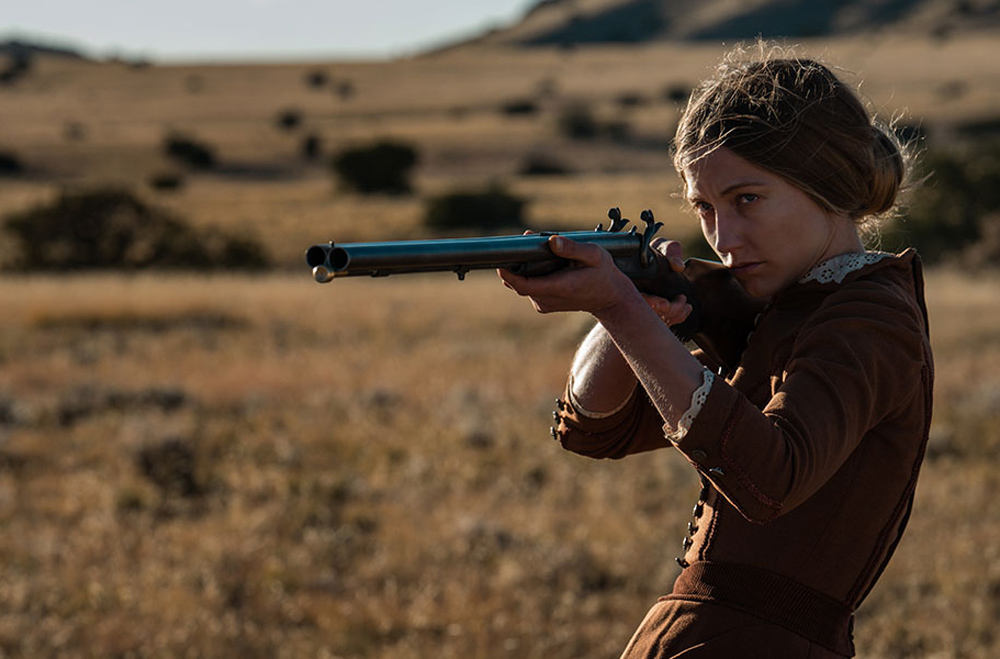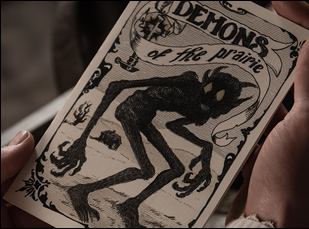It was an occupational hazard Emma Tammi could see coming a mile away when working on “The Wind,” yet when her narrative feature debut’s very premise revolved around how the constant, hollow sound of the breeze could drive someone insane, the weeks spent perfecting the film’s sound mix were bound to take their toll.
“We listened to every type of wind that’s ever been recorded and we used a lot that we recorded, and we’ve used many, many others with different textures,” said an exasperated Tammi, who nonetheless reasonably chipper the day after the film’s well-received premiere at the Toronto Film Festival. “Who knew there were so many different wind sounds? We now know.”
For as much stirring there is on the open range in “The Wind,” the result is a disquieting horror western centered on Lizzie Macklin (Caitlin Gerard), who can no longer be sure whether what she’s seeing is real or not when her husband Isaac (Ashley Zukerman) leaves for work and all she has is her livestock, her imagination and that roiling sound of the wind. As Teresa Sutherland’s devilish script gradually reveals, it wasn’t always this way as the Macklins welcomed new neighbors Emma (Julia Goldani Telles) and Gideon (Dylan McTee) to a parcel of land sitting just besides theirs and the couples became close – perhaps too much so, which continues to haunt Lizzie, making the past and present constantly intersect.
The less you know about where “The Wind” is headed, the better, but the painstaking work by Tammi, Sutherland and a dedicated crew to immerse audiences in the period demands to be acknowledged, with the director sending out a sound designer to New Mexico before filming commenced to get the creaks in the floorboards of the 19th-century homestead just right, composer Ben Lovett pulling out era-appropriate instruments such as bass lutes and reed organs, and production designers Hillary and Courtney Andujar’s extraordinarily detailed sets that alternate between the real and surreal simply by adhering to beliefs of the time that took root when so little was known or could be communicated out on the Plains. But although “The Wind” transports you to a time long ago, Gerard’s fearless performance snaps it back into now, a vivid portrait of isolation that takes into consideration the female experience of the West that has often been overlooked on screen. Both terrifying and energizing, the film is apt to make your hair stand on end and in advance of the film’s West Coast premiere at Beyond Fest in Los Angeles where the film will be playing twice on October 2nd, Tammi, Sutherland and Gerard, who needed to catch a flight midway through our talk, spoke about teaming up for the chiller, embracing madness and reworking the film around what elements they had available to make for a richer experience.
Teresa Sutherland: I’m from Missouri and lived in Kansas for a while [where] I used to be a part of the community garden. It was just a bunch of old women and me, just gardening on the plains of Kansas, and the wind is real loud there. We couldn’t hear each other talking, and when people were trying to talk to me, I was like, “I can’t hear you. I’m just gonna pull weeds.” Then on the way out, one of the other women comes up to me and she’s like, “You know it used to drive women crazy?” And I was like, “What?” And she’s like, “The wind. They heard it all the time and it drove them crazy.” So I was like, “Yes, tell me everything. I need to know.” Five years later, I’m finally in film school and I have to do a thesis, so I thought, “I want to tell that story,” so I do more research, and we do this short, and then five years later, we’re here – with more research. [laughs]
It seems unusual to me that you’d actually hand this off to another director after you directed the short from your own script. How’d that happen?
Teresa Sutherland: That was through Chris Allender at Soapbox. We went to the same film school and [when I was there] he was there as a speaker. He saw the short and loved it and every once in a while, he’d be like, “Hey, what would this look like as a feature?” And it’s just one woman in the short, so [I thought] “I don’t know where to go with this.” But finally, my brain just clicked, like, “Don’t remake the short. Go back in and find new characters and find where they are and find their story.” Once we did that, it was a very quick writing process, and I knew I wanted a woman to direct it, so when we met Emma, and I [thought] immediately, she gets it.
Emma Tammi: I had done post production on a documentary with Chris at Soapbox, and they mentioned Teresa’s script to me, and knew that I wanted to do something in the narrative space, so when I read it, I just fell in love with the characters. The character of Lizzie was so nuanced and well written and I loved all the research that Teresa had based the script on. In that time period, there were all these actual accounts of women just surviving on the land, trying to stay sane in the process and having varying degrees of success doing that, so Inwas fascinated by the premise, and then departing from that and going more into the supernatural and horror space was just so fun. But at the root of it, the characters were really, really deep and it was grounded in some drama that felt relatable in my life in 2018, so I was like, “Well, if it resonates on that level to me now, there’s really something here.”
Caitlin, how’d you get mixed up in this craziness?
Caitlin Gerard: It was crazy. I love westerns, and I got [the script] under very short notice and I normally don’t like to go into something when I haven’t had enough time to think about it, so I had this really weird experience where I [thought] ” I just don’t know if I can do it,” but then I read it that night, woke up the next morning, and I was like, “Oh, yeah. I got it.” Lizzie resonated so much with me and I went in there – I’ll never forget this – and you have the audition process [where] they have you do various scenes to see your range, and it was three scenes of Lizzie slowly losing her mind, and I knew that the director was gonna be there, and you don’t always have that opportunity, so I was super excited because I thought, “Okay, great, we’re gonna collaborate,” but I get in there, and Emma’s completely poker-faced. I do the first scene and the casting director looks over at Emma and Emma just nods very stoically, and the casting character’s like, “Okay, let’s go on to the next one.”
We do the next one, and Lizzie’s lost her mind a little bit more, and I look up when I’m done with the scene for some feedback, and again, just a solid nod. And then in the last scene she loses her mind completely, and I thoughtI’d have some time to prepare, but I just have to go right into it, so I was like, “I’m not going to keep losing it until they tell me to stop.” So I remember the casting director [finally says], “Okay, okay. Thank you.” And I walked out of that audition having no idea [if I got the part].
Emma Tammi: Yeah, we hired you 30 minutes later.
Caitlin Gerard: Yeah, and that’s never happened in my life. In that moment, I thought oh my god, I’m working with someone who knows exactly what she wants. For Emma to have watched my performance, and been happy with my choices, and not tested them, that level of confidence is something that as an actor, I need from the director. Emma was so strong and assertive, but in a way she was a container that allowed me to lose my mind in a way where I knew I would be safe. I wouldn’t get too lost, or go too far. That’s really, really important when you are allowing your own psyche to go there.
It was interesting to hear that you were able to adapt the character to Caitlin and Julia Goldani Telles before shooting since they spoke multiple languages. What was it like figuring that out on the fly?
Emma Tammi: Yeah, it was something that we definitely didn’t want to feel tacked on because we were adding things at the last minute, but it was really just building on what the foundation was already.
Caitlin Gerard: But you talked about her being an immigrant before I came along.
Emma Tammi: Absolutely. And Teresa was in New Mexico with us before we shot, so we were all able to be on the ground, making those tweaks in real time together, and finding what felt organic to the story.
Caitlin Gerard: It was just adding another layer to character work, which was really exciting because allowing us to do that just tapped in to the German folklore that exists…
Emma Tammi: Which was an extension of all the religious components of the film that Teresa had.

Emma Tammi: This was originally set in Kansas in the script, and then we started location scouting and for a number of reasons, New Mexico was really inspiring. The light is incredible, there’s a vastness of the land, and there’s something iconic about the western landscapes that New Mexico embodies, which also felt like playing more into the folklore aspect of it than grounding it specifically in a territory. [Like] once upon a time, in the Great American Desert.
We were staying in Santa Fe during the shoot, but we were spending very long days and nights in these cabins and in this prairie land, so it was like living there, and it was gorgeous. Everyone there was really invested in it, and we’d have wild horses roam through set, and we’d stop shooting, like captured by the magic of that land. And no one’s cell phones worked, which was the best thing ever because we all felt that we could be present in the moment and transported to a period of time where technology wasn’t running our lives in the way it does now. When you’re on a big budget shoot, you can probably mandate the cast and crew to turn off their phones, but we weren’t that and the fact that everyone was just really dialed in and tuned out of their cell phones was such a gift.
And you built sets where you could shoot 360 – why was it important to create that immersion?
Emma Tammi: We didn’t build the cabins. Those did already existed, but once we landed on the location, it felt like this is the foundation for the world that we’re gonna build for both of these houses and these women because each of the houses were such an expression of the characters and our art department really took it from there. This art department was magic and I still don’t know how they did what they did, especially on the budget we had, but every day it was like a new treasure would arrive. [You’d open] the trunk of the chest that’s in the film and there are blankets [from the period], and Emma’s diary, and you realize we’re sitting here looking at pages that someone wrote in this time period. There was a magical quality to having that tactile connection to the time period and I think the actors really felt that. I remember just shooting in one direction, turning around in the next, and seeing a whole corner of a world that I hadn’t even noticed yet, and every detail of the space was given so much attention, so much thought and care.
Teresa Sutherland: It was beautiful. It was so incredible because I was the originator of the research, and the first couple meetings with Emma, I was just like, “Here’s some books. Look, I highlighted everything in this book for you, read that.” But I didn’t feel like I had to fact check anything because Emma knew everything, Caitlin knew everything, the [production design team] knew everything. Everybody was just so involved and so immersed in it, and excited about the time period that it didn’t feel like it fell on any one person’s shoulders. Everyone was just there in it.
Ben Lovett, the composer, mentioned finding all these obscure instruments to use for the score. Were you finding ways to incorporate the period into the fabric of the film, like perhaps using vintage lenses?
Emma Tammi: We actually used anamorphics, which was [acknowledging] the landscape that we were shooting in, which is obviously wide and open and just fits into an anamorphic aspect ratio so beautifully, and we wanted there to be a fresh take on something that felt nostalgic. But the music definitely tapped into an authenticity of the time period and we wanted the sounds and even the visual effects to feel organic to the world. Sometimes you can layer things on to that, that oppose it in interesting ways, and every time we dabbled with an element that didn’t feel of the world, it just didn’t fit, so we were trying to find what felt good in this world.
With a fractured narrative like this dealing with memory, was the structure pretty locked into place before the edit or did it take some time to figure out?
Emma Tammi: It was a challenge. Teresa wrote the script in a nonlinear way. Obviously it is edited that way as well, but the structure departed from the page pretty dramatically in the edit and it took us a minute to crack the essence of what Teresa had written on the page, so it wasn’t a direct correlation. It took a while to get a rhythm for the different timelines that didn’t feel confusing, but also not hand holding, so the audience could be carried on a journey where they weren’t disoriented enough that they wanted to leave, but they were still asking questions along the way. and that’s what we were really hoping to achieve. We wanted you to feel invested with these people so that you were ready to take the journey, but that journey skipped around in several different places throughout their lives.

Teresa Sutherland: We were all so excited to finally have people see this story that we’ve lived with for so long, and of course there’s jitters, like what’s gonna happen? I hope people jump, and sitting there watching it, hearing laughter at parts we thought were funny and then hearing like, “Oh, shit,” at parts where it’s the scary part, it was a great experience because it felt like sitting in a theater watching a horror movie, having nothing to do with it. When a horror movie is reaching people, I experience the gasps and the people laughing at that person who said, “Oh my god” out loud, just the total immersive involvement of everyone, so the more I heard that, I was like, “We’re okay, guys. Everything’s fine.” It was exciting to be in that environment and at the end to see, “Oh yeah, we did this.”
Emma Tammi: Our whole team was there and that was really amazing because everyone put so much into this, and the Midnight Madness crowd here brings so much enthusiasm and so much excitement to the table that is really unique. As Teresa said, to hear the gasps breathed a lot of life into the film. This is a slow burn and I didn’t know if it would resonate with the Midnight Madness crowd would resonate with it straight out the gate, but they were really with the film, and that was wonderful.
“The Wind” opens on April 5th in New York at the IFC Center and Los Angeles at the Laemmle Glendale and the Music Hall. It is also available on VOD.





